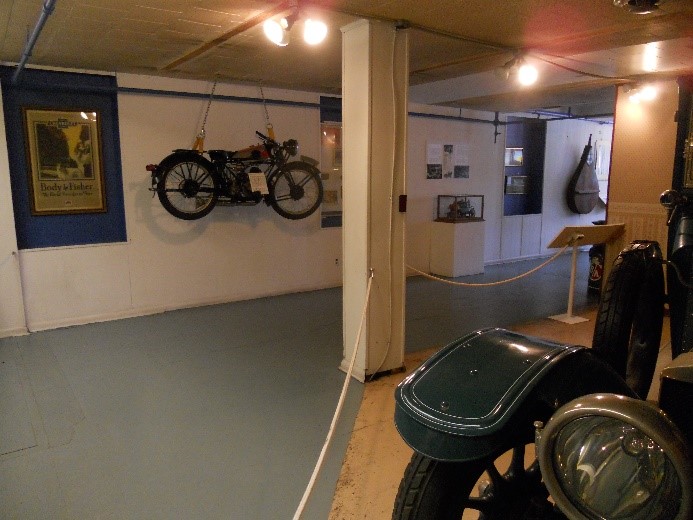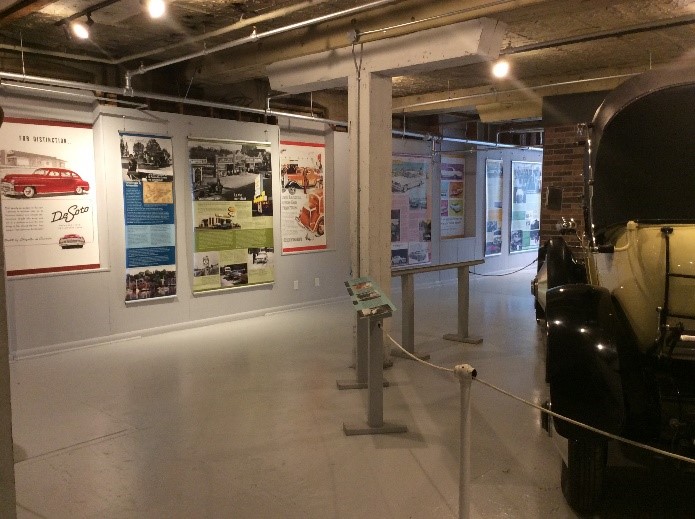ENERGY CASE STUDY
CANADIAN AUTOMOTIVE MUSEUM
 In 2016, ArtsBuild Ontario offered a one-time grant for energy conservation projects, as part of our Energy Conservation Program. We were pleased to offer the grant to eight arts organizations, all taking on a new renovation or project that would result in lowering their monthly energy use.
In 2016, ArtsBuild Ontario offered a one-time grant for energy conservation projects, as part of our Energy Conservation Program. We were pleased to offer the grant to eight arts organizations, all taking on a new renovation or project that would result in lowering their monthly energy use.
One of our grant recipients was the Canadian Automotive Museum located in Oshawa, Ontario. They completed a lighting retrofit project in the lobby and gallery in their museum. Several months after completing the project, we followed up with Executive Director and Curator Alexander Gates to see how the lighting retrofit has reduced their energy use and affected the space.
WHY TAKE ON A LIGHTING RETROFIT PROJECT?
In 1963, the Canadian Automotive Museum made its home in a century old former car dealership building, located at 99 Simcoe Street South. Over the years, the museum has taken on building projects to maintain and upgrade the facility to accommodate its ever-growing roster of programs and exhibitions. The museum has taken on previous energy conservation projects, including the installation of a white roof that reduces heat retention in the building in the summer months. Part of the lobby area was also renovated in 2015 where a portion of the lighting was replaced with LEDs.
Lighting improvements in the remaining lobby space and gallery became a project area for the museum as a result of visitor feedback. Patrons noted that the museum looked dark inside, as the former floodlighting highlighted the vehicles on display, but left visitor pathways in the dark. The museum deliberated on how to create a brighter space while cutting down on energy costs.
A lighting retrofit with energy efficient LED lights proved to be a successful and cost effective alternative to the traditional floodlights. “LED lights use a lot more light, less heat and have better quality lighting that is actually better for the exhibits. Incandescent and florescent lights tend to bake the objects and can fade materials,” notes Alexander. Adding higher wattage bulbs would only create more heat and use more electricity, so the museum looked to LED track lighting as a solution. The museum worked with a volunteer who is an electrician to pick out a cost effective system for the project.


Before: Hallway lighting in 2015 After: Hallway lighting in 2017
IMPACT IN THE SPACE
The lighting retrofit resulted in an improved experience for visitors by brightening walking areas. Prior to the retrofit, the museum’s car collection was the lighting focus of the gallery space. While the cars had the spotlight, visitors were left slightly in the dark as they walked through the exhibition. “We want people to have light on them too, so they can do activities like a puzzle or worksheets; not sitting in the dark while the cars are being lit. So now there is definitely a warmer feeling in the space,” shares Alexander. The LED track lighting resulted in a fully lit space that improved the appearance of the kids’ space and visitor areas.
The new LED track lighting has amplified the appearance of the museum’s displays – especially the cars. Objects were previously lit in the front and sides, which created shadows and caused a lot of reflection, making it difficult to take photos. Now, the new LEDs provide even lighting and actually bring out the true colours of the vehicles on display. “The vehicles had been viewed only indoors prior to the lighting changes, and were presumed to be the colour black when in fact some are very dark blues and lavenders.”
OVERALL SAVINGS ON ENERGY AND COSTS
The museum replaced its previous incandescent lights with LED lighting in the gallery and lobby spaces with a goal to reduce the number of kilowatt-hours used in the 25,000 square foot facility. The incandescent lighting fixtures used approximately 10,000 watts; this LED retrofit would see usage reduced to 1500 watts. In addition to lowering energy use, the museum’s electric bill has decreased by 35% compared to the year before as a result of this lighting retrofit and other energy saving initiatives. The new LEDs have so far saved the museum $2,000 in hydro costs.
In addition to building projects, the Canadian Automotive Museum cuts down on hydro by turning off the lights when visitors are absent. “One thing we try to very cognizant about is turning off the lights when we don’t have visitors,” mentions Alexander. “I want to let others know that it actually does make a difference to your bottom line to have all the lights on in the gallery when no one is there.” The museum operates during peak periods of electrical usage, running Monday to Friday from 10:00 a.m. to 4:00 p.m. The entire team of staff and volunteers makes a point of turning the lights off when there are no visitors, such as during the first 20 minutes of the day.
UPCOMING ENERGY PROJECTS
The Canadian Automotive Museum is taking on additional energy saving projects this year. With plans to improve the façade of the building, the museum is planning to install metal cladding with a layer of insulation around the facility. They will replace exterior doors that will also contribute to lower energy use. The museum is in need of an HVAC system replacement, and in the middle of a fundraising campaign to support the project. All these projects combined with current energy saving initiatives will continue to reduce the museum’s overall energy use and hydro costs.

